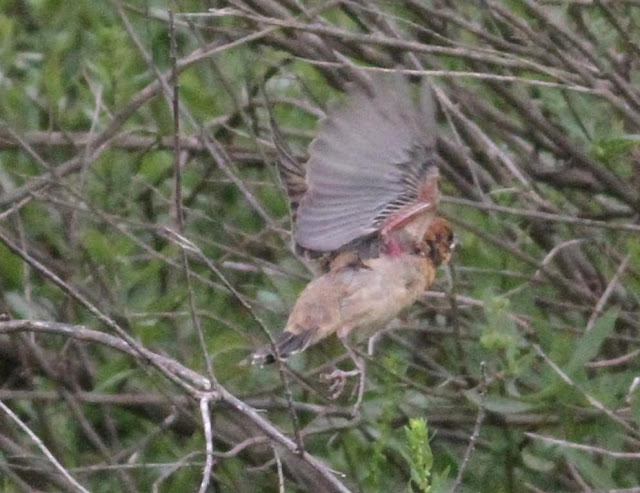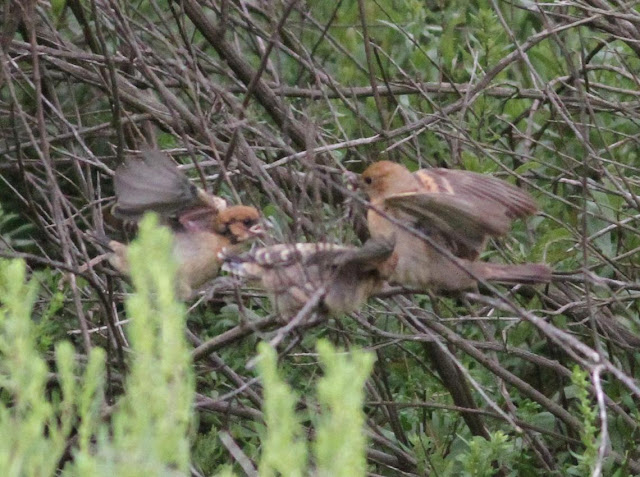Everyone loves treasure hunting. As a birder, finding a
bird that you have been looking for for months is like finding a rare gemstone. In
this case a beautiful sapphire colored bird called the Blue Grosbeak. Eve had
e-mailed me to let me know that her friends, Patti and Patrick took her to a new
spot in Sorrento Valley at the end of Flintkote Ave and that they had spotted a family of Blue Grosbeaks and a
glut of Yellow-breasted Chats. Even a Rose-breasted Grosbeak was reported to
have been spotted there. She wanted to know if I was interested in going for a day trip and I couldn't type fast enough to say "Yes, let's
go"!
Using the windshield wipers on my truck to wipe off the
drizzle that was caused by the coastal eddy, I was keeping my fingers crossed
that the weather would clear by the time we got to Sorrento Valley. The drizzle
stopped but the overcast skies were going to stick around for awhile. The first subject I found as we arrived at the trailhead was a young
Allen's Hummingbird.
Just a few blocks from the entrance to the trail and... There he
is! The male Blue Grosbeak sitting on top of a sprinkler in na area that is being
replanted to bring the area back to natural native vegetation.
Blue Grosbeak, Passerina caerulea measures 6.75
inches with a wingspan of 11 inches.
Eve spots a female Blue Grosbeak landing next to her fledgling. The adult female, on the left, is
gray-brown colored. Only the male has the blue coloring.
She proceeds to feed her youngster.
She takes off to get more food.
Looking south of the Blue Grosbeaks, we spot a snag full of young
American Kestrels. Here we see one coming in for a landing.
A cautious approach. One youngster flaps his wings as if to say this branch is
taken.
The approaching youngster finds a vacant branch for a landing.
Being careful with full concentration on his landing.
We have success and a very nice landing.
As we were watching to see where the female Blue Grosbeak went to gather food for the youngsters, a couple of Nutmeg Mannikins (recently renamed to Scaly-breasted Munia) landed right in front of us. Nutmeg Mannikin, Lonchura punctulata measures 4 inches long with a wingspan of 7 inches. Originally escaped pet birds, the munia have now successfully established themselves in the wild.
They took off but we spotted this flycatcher on another snag. I think this may
be a Western Wood-Pewee. Contopus
sordidulus measures 6.25 inches with a wingspan of 10.5 inches.
We found the male Blue nearby keeping an eye on the area where we saw the chick
being fed by the female.
Keeping an eye on us too!
Another flycatcher was spotted in the area and this one Eve identified as an
Ash-throated Flycatcher. Myiarchus cinerascens measures 8.5 inches long with a
wingspan of 12 inches.
The male blue comes a little closer for a nice pose.
Nice shot of the back.
He is looking at something in the tall grass. I check in the area and the female
is busy collecting seeds.
Here is the female collecting food for her fledgling.
She lands on top of the grass stem and proceeds to collect the seeds.
She finds her fledgling and offers food.
The fledgling lands in a little bare bush.
The male flies to check on the fledgling but does not feed him.
He is making sure the little guy is safe as the mom is busy collecting seeds.
He spots the female coming to the fledgling and takes off.
The male leaves the fledgling and perches on top of a tall tree to keep a lookout
for any intruders.
Here is the female flying in to feed the hungry youngster.
Wow, as the female feeds one youngster, another one flies in. (The female
feeding the youngster is hidden by the greenery in this photo.)
The mom takes off again to load up on more food. The two fledglings sit and wait
for food but call out constantly to remind the parent that they are very
hungry.
The female Blue Grosbeak, in the middle, is back on the branch feeding one of her chicks. The
one on the left is begging constantly wanting to be fed too.
Feeding continues.
The mom looks at the chick on her left and knows she has to go get more food.
"Where's my food, mom?" The female looks surprised at the demanding call of her
youngster.
The female takes off to get more food. The two chicks wait but constantly watch
for mom.
One of the fledglings sees something and takes off.
Flying is a little new to this little guy and looks a bit awkward.
It's mom coaxing the youngsters to fly to her. One goes over but one stays put.
The one that stays put is going to make mom come to him for food service.
Dad drops in to check on the youngster. The chick begs for food but dad is on
guard duty.
The male blue stays with the youngsters always the protector.
Still keeping an eye on us too.
There's mom coming back to the chicks.
As the female lands the other chick comes flying back to the original bush.
The hungry one gets fed quickly and she leaves to get more.
A shot of the two chicks while they wait to get fed.
They are so adorable.
Dad comes again to protect. Notice that the chicks are calm and not begging for
food.
One on the left has his eye on mom.
Mom must be close because the one on the left is starting to chirp.
He has his wing out begging.
Calling for food.
Both chicks are now begging. The male starts to depart making room on the branch
for the female.
Wings out and begging.
The male departs seconds before the female lands ready to feed.
He wants to be fed now!!
Feeding
Mom looks to the other chick for signs of hunger. Yes, he is still hungry too.
Another serving for the one with its mouth opened wide.
Not to waste one seed, the mom continues feeding.
A good feeding for this little guy.
A few more shots of the feeding.
Great feeding session for the youngster. The one on the left waits patiently.
Even with a good feeding the chick is still begging for more food.
And the mom complies!
Finished with her seed supply, the female takes off to gather more. The male
again flies over to his youngsters to keep them safe.
Looks over our way as if to say "enough already, get going". LOL, it's time for us
to leave anyway. Sorrento Valley is a wonderful place to bird. A wonderful place
to treasure hunt, finding the beautiful gemstone colored bird called Blue
Grosbeak.
As we walk back towards the parking area, the ever present Yellow-breasted Chat
makes an appearance and sings his heart out for us.
As we near the entrance gate, I spot this beauty. It looks like an Anna's
Hummingbird but he has a green crown. I think I am looking at a
Black-chinned Hummingbird!
Wow, a life bird for me! Black-chinned Hummingbird, Archilochus
alexandri measures 3.75 inches long with a wingspan of 4.75
inches.









































































No comments:
Post a Comment